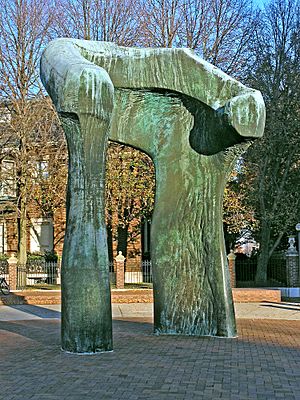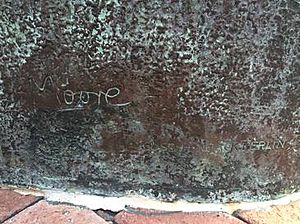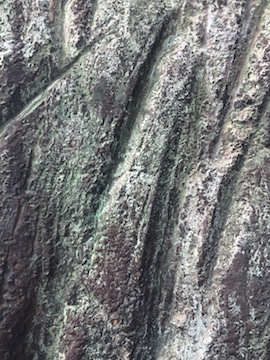Large Arch facts for kids
Quick facts for kids Large Arch |
|
|---|---|
 |
|
| Artist | Henry Moore |
| Year | 1971 |
| Type | Bronze |
| Dimensions | 5.9 m (19.5 ft); 3.8 m diameter (12.5 ft) |
| Location | Cleo Rogers Memorial Library, Columbus, Indiana, United States |
| 39°12′13.37″N 85°55′6.97″W / 39.2037139°N 85.9186028°W | |
| Owner | Cleo Rogers Memorial Library, Public Library of Bartholomew County, Indiana |
Large Arch is a huge outdoor sculpture created by the famous British artist Henry Moore. It was put in place in 1971. You can find it in the public plaza outside the Cleo Rogers Memorial Library in Columbus, Indiana. Xenia and J. Irwin Miller asked Henry Moore to make this sculpture. They then gave it to the library as a gift. The sculpture stands almost 20 feet tall. It is made from bronze using a special sandcasting method. Its surface has a unique aged look called a patina.
Contents
What is Large Arch?
Large Arch is an abstract sculpture made of bronze. It was designed by Henry Moore. The shape of the arch looks a bit like human hip and leg bones. The empty space inside the arch can make you think of a human body without a head.
This sculpture is very tall, standing 19 feet 6 inches high. At its base, it is 12 feet 3 inches wide. But at the top, it gets wider, reaching 13 feet 9 inches across. Even though it is hollow, the sculpture is very heavy. It weighs about 11,000 pounds!
The sculpture was made in about 50 separate pieces. These pieces were then put together in Germany. The surface of the sculpture feels smooth. You can barely see where the different parts were joined. The sculpture was first colored a green shade called Paris green. Over time, the color has changed. Now, parts that get a lot of rain have a light blue color. The surface also has deep wrinkles and a rough feel. This was part of Moore's original design. Architect I.M. Pei called it "elephant skin."
The sculpture sits in a round plaza paved with red bricks. This area is for people to walk around and enjoy.
How the Sculpture Was Made
The artist Henry Moore said he was inspired by Stonehenge in England. He also thought about the shape of a man's shoulders. Before making the Large Arch for Columbus, Moore created a smaller bronze arch. It was called Large Torso and is now at the Museum of Modern Art (MoMA).
The architect I. M. Pei had an idea for a big artwork. He wanted something special for the plaza outside his new Cleo Rogers Memorial Library. He hoped it would connect the library with the nearby Irwin Gardens and the First Christian Church. Pei wanted a sculpture that people could touch and even walk through.
He saw Moore's Large Torso at MoMA. He watched his daughter play inside the small arch. This gave him an idea. Pei asked Henry Moore to make an arch twice as big. He wanted it large enough for two adults to walk through side-by-side. Moore agreed, as long as it wasn't so big that a car could drive through it. Moore also let Pei and J. Irwin Miller decide where to place the arch. He trusted them to think about how people would approach it and how the sun would shine on it.
Large Arch was made in 40 to 50 pieces. These pieces were cast in Berlin, Germany. Each piece was about a quarter of an inch thick. The parts were shipped to New Orleans. Then they traveled by boat up the Mississippi River and Ohio Rivers. From New Albany, Indiana, the sculpture was driven on a large truck to Columbus, Indiana. It was then put together as one big piece. Before the real sculpture arrived, a temporary wooden model was put up. This helped people imagine how big the final sculpture would be.
The library's official opening happened on May 16, 1971. This was two years after the library building was finished. The dedication ceremony took place when Moore's sculpture was installed. I. M. Pei was there and gave a speech. He talked about the plaza as a public space. He said it showed how important the nearby buildings were. Other important people were also there, but Henry Moore did not attend.
Even before it was placed, Large Arch caused some talk in the community. People gave it funny nicknames like "Dentist's Dream" or "The Big Bone." Today, the arch is a popular stop on tours of Columbus. Henry Moore himself thought it was one of his most important artworks.
Where is it located?
Large Arch was made especially for the public plaza. This plaza is outside I. M. Pei’s Cleo Rogers Memorial Library in Columbus, Indiana. The sculpture's soft, natural shapes stand out against the hard, geometric designs of the library and the First Christian Church.
The plaza is round and paved with bricks, like a Roman style. The arch is in the middle of a slightly raised area. In the past, cars could drive around the arch. They could even park there for a short time. But this road was later closed. Now, it is a special area just for people to walk. The plaza is designed for everyone to use. The plaza was repaired in 2013-2014, but Large Arch is still there for everyone to see.
Other similar bronze arches by Henry Moore can be found in different places. There is one at the Museum of Modern Art in New York City. Another is at the Lynden Sculpture Garden in Milwaukee, Wisconsin. You can also see one at the Nelson-Atkins Museum of Art in Kansas City, Missouri. Moore also made a similar arch from travertine stone. This one is on display in Kensington Gardens in London, England.
Who paid for it?
The Bartholomew County Library board approved Large Arch. Xenia and J. Irwin Miller paid for the sculpture. This was suggested by I. M. Pei. The Millers then gave the artwork to the Cleo Rogers Memorial Library.
About the Artist
Caring for the Sculpture
Sometime between 1971 and 1985, a special seal was added around the base of Large Arch. This was done to stop water from collecting. It also helps prevent damage from freezing and thawing.
In 1984, Large Arch was spray-painted. Someone painted a white letter "A" on one side of the sculpture. Experts worked to remove the paint. They also suggested putting a special wax on the sculpture. This wax would protect it from future paint attacks. The library also contacted Henry Moore's studio for advice. They wanted to make a plan for how to regularly care for the sculpture.
Images for kids




